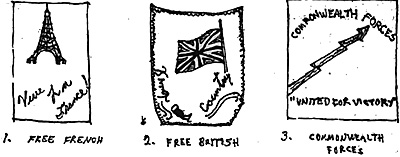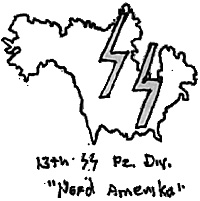 North American Campaign WWII Invasion (WN 114)
North American Campaign WWII Invasion (WN 114)
Naval Forces:
Remnants of the Royal Navy fled to the United States after Britain fell, where they joined Free French units (like the destroyer "Le Fantasque").
Later, units of the Commonwealth Navies came to America as their respective countries fell. Most of the Commonwealth units are in the Pacific. Some of the planned vessels of the U.S. (such as the "Montana") are being built but are not yet combat ready.
Units of the South American Republics are rapidly joining American task forces, and have fought in one battle (The Battle off St. Paul's Rocks
III. Uniforms:
Most of the Allied troops in America are equipped with standard U.S. Army olive drab uniforms. The various groups of troops from occupied countries fighting in America have their own distinctive patches. (See figures 1, 2, 3).
IV. Vehicle Markings and Camouflage:
All vehicles, no matter what the national origin of their crews, are marked with white stars on the turret sides and/or on the front and rear of the vehicle. Markings of national origin (flags, etc.,) are allowed only the rear plate or sides of a vehicle.
Most Allied vehicles are painted a basic forest green or olive drab. There have been a few attempts to camouflage armoured vehicles by adding stripes of different shades of green from the basic colour. These measures are the exception rather than the rule.
 B. THE AXIS FORCES
B. THE AXIS FORCES
I. Land Forces:
At this moment we are interested mainly in German forces, as the other Axis forces are acting only in a supporting role, so German equipment will be discussed now.
All small arms are considered the same as those used during the actual 1939-45 conflict. As to armoured vehicles, the Germans are relying still on the PzKfw IV H, which in gradually being replaced by the heavier PzKfw V Panther. The Tiger I and Tiger II (King Tiger) are the standard tanks of the German Heavy Panzer units, but have not yet been used in great numbers because of their bulk and slow speed.
The Germans have a wide selection of self-propelled guns. Among these are: JgdPz IV, Hetzer, Sturmgeshutz III (75mm/StuK40), Sturmgeshutz III (105mm/StuH 42), Nashorn, Hummel, Brummbar and Grille 10 (88mm). Artillery consists of the Light Infantry Howitzer 75mm, M18 105mm Howitzer, M18 150 Gun, 150mm and 210mm Nebelwerfers (these are also mounted on the Schwerewehrmachtschlepper half-track). Anti-tank artillery includes 75mm PaK 38s, 88mm PaK 43/41s and 128mm PaK K44. Anti-aircraft weaponry includes the 20mm, 37mm, 88mm and 128mm Flak guns. There are also the FlakPanzers Ostwind (37mm), Wirbelwind (4 x 20mm), Mobelwagen (37mm), quad 20mm SPAA and Klugelblitz (2 x 30mm).
The armoured personnel carriers being used by the German forces are the SdKfz 25 250 and SdKfz 2.51. So far, only these variants have been in use in America: SdKfz 250/10, SdKfz 251/9 (37mm PaK), SdKfz 251/2 (80mm Mortar). The unarmoured SdKfz 8 and SdKfz 11 are in use as artillery prime movers. The Type 82 Kubelwagen and Schwimmwagen are also being employed much as are the American jeeps.
For scouting units, the Germans use the SdKfz 234 series of armoured cars, which includes the SdKfz 234/1 (20mm gun), SdKfz 234/2 (50mm gun), SdKfz 234/3 (short 75mm) and the SdKfz 234/4 (long 75mm).
Soft-skinned vehicles include Opel "Blitz" trucks$ Hanomag and Horch medium cars, also captured Allied vehicles.
II. Naval Forces:
These include the naval forces of all the Axis countries listed in THE WORLD SITUATION 1940-1947. The planned H-42 and H-44 class German battleships have been completed, The German aircraft carriers "Graf Zepplin" and "Peter Strasser" are being used in conjunction with the Italian carrier "Aquila".
III. Uniforms:
At the beginning of the campaign, the Oberkommando der Heeres authorised the following uniform as standard issue for invasion troops: Jackboots, field grey trousers, a camouflage smock (with a pattern of browns), and a helmet cover patterned to match the smock.
There are expected to be other types of uniform for future areas of operation.
IV. Vehicle Markings and Camouflage:
Armoured vehicles have their tactical numbers painted on turret sides and rear plates. The German national cross is placed in the same areas as the tactical number. Divisional signs and tactical signs are painted on the front right and rear right fenders. Vehicles are painted a basic earth brown with a camouflage pattern of olive drab stripes or spots.
V. Special Insignia.
There is only one special insignia so far in the campaign. It is the divisional sign of the newly formed 13th SS Panzer Division "Nord Amerika" (North America). This insignia shows the SS runes superimposed over a map of North America. It is figure number 4.
Back to Table of Contents -- Wargamer's Newsletter # 115
To Wargamer's Newsletter List of Issues
To MagWeb Master Magazine List
© Copyright 1971 by Donald Featherstone.
This article appears in MagWeb.com (Magazine Web) on the Internet World Wide Web.
Other articles from military history and related magazines are available at http://www.magweb.com